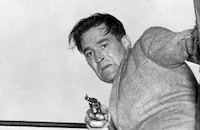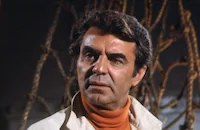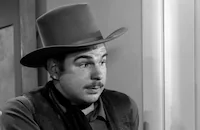Inside the Walls of Folsom Prison

Brief Synopsis
Cast & Crew
Crane Wilbur
Steve Cochran
David Brian
Philip Carey
Ted De Corsia
Scott Forbes
Film Details
Technical Specs

Synopsis
In the first half of the twentieth century, at California's maximum security Folsom Prison, unhealthy conditions and brutal treatment are considered by the cruel, old-school prison warden, Rickey, to be the only way to handle the three-time convicted felons. One Sunday, against the advice of ringleader Chuck Daniels, several prisoners attempt a breakout. Although the riot is quickly suppressed by Rickey, two guards are killed along with several prisoners. Harsh punishments are meted out to those involved, and a Sacramento Press reporter, Jim Frazier, investigates a rumor that one of the instigators of the rebellion was beaten until paralyzed. Because of the prison's recent problems and changing societal views regarding the treatment of inmates, the prison's board of directors orders that new blood be infused in the system and sends penologist Mark Benson to serve as captain of the guards. On his way to the prison, Benson meets Jane Pardue, whose good-natured, young, inmate husband Red has truly reformed and anticipates a parole. Rickey and his right-hand man, Sgt. Hart, show Benson around, and although Benson acknowledges that the hardened men have committed the most heinous of crimes, he also notes that they suffer from inhumane conditions, spoiled food and senseless, morale-shattering regulations. When Benson expresses his desire to make changes, Rickey condescendingly allows him free reign, expecting that he will soon discredit himself with his weak, psychological approach. Benson orders the cleaning of the living and work areas, arranges for better food, including meat, to be supplied by the prison ranch, and allows the prisoners to converse during meals. He puts an end to impulsive beatings and insists that the uneducated, trigger-happy guards come to work clean and behave professionally. Believing that parolees, such as Red, need help in adapting to life "outside," he offers them job-hunting assistance. Later, Red, a demolition expert working in the prison quarry, is sent to town with a guard to pick up supplies. As the guard checks them out of the gate, Red realizes that a fellow prisoner, Nick Ferretti, is hiding under the car seat. Knowing that he will be blamed for Ferretti's escape, Red silently alerts the guards and Ferretti is captured and placed in solitary confinement. Fearing the prisoners' retribution, Benson urges Rickey to move Red to a different cellblock for his safety, but Rickey makes little distinction between the inmates who make trouble and those who cooperate, and refuses. Troubled by his act of betrayal, Red tells his cellmate Daniels, but the hardened criminal says that Red had no choice, as he would have taken the rap for assisting in Ferretti's escape and had his parole unfairly cancelled. Daniels, who fully trusts Red with his own carefully laid escape plans, worries that the prisoners will learn about Red's tip-off. Meanwhile, from inside his "solitary" cell, Ferretti has learned from an eavesdropping prisoner that Red turned him in and bribes another prisoner, Tinker, to avenge him. Because Red has a good reputation among the prisoners, Tinker at first cannot believe the accusation, but his greed decides his actions. Red is killed in an explosion in the quarry on the day before he is to be paroled, and Daniels, guessing who is behind the accident, secretly plans revenge. After telling Jane the whole truth about Red's death, Benson accuses Rickey of murder, as he did not try to protect Red, and in retaliation, Rickey revokes all of the reforms. Life again becomes unbearable for the prisoners and Daniels, who has been secretly stockpiling explosives for an escape, prepares his followers for a breakout. He manages to take a cell guard, then Hart, as hostages, and orders Rickey to release them. Disguising himself as a prisoner, Rickey gains entrance into the cellblock and begins shooting, but when he is killed, a shoot-out commences between guards and prisoners. After taking over, Benson calls in the state militia, cuts the electricity in the cellblock and gives Daniels five minutes to surrender. Knowing he is defeated, Daniels releases the prison guards and the uninvolved prisoners, except Ferretti and Tinker. Tinker, who knows Daniels plans to avenge Red's death, grabs a gun from one of Daniels' cohorts and shoots, setting off the explosives, and all in the cellblock are killed. In the following years, with men like Benson in charge, the prison board modernizes the facility and its programs, so that the prisoners have a better chance of being reclaimed for society.

Director

Crane Wilbur
Cast

Steve Cochran

David Brian

Philip Carey

Ted De Corsia

Scott Forbes
Lawrence Tolan

Dick Wesson

Paul Picerni

William Campbell

Ed Norris

Dorothy Hart

Matt Willis
Damian O'flynn
Sheb Wooley
Charlie Lunge

James Griffith
Tom Dugan

Mari Aldon
Charles Horvath
Crew
Douglas Bacon
Gordon Bau
Joseph I. Breen Jr.
Elmer Decker
Edwin Dupar
Bryan Foy
Stanley Jones
William Kuehl
William Lava
Owen Marks
Charles Maxwell
Jim Mcmahon
Crane Wilbur

Film Details
Technical Specs

Articles
Inside the Walls of Folsom Prison
By placing its story in the past, the show pretends that all the problems in the story have been solved, and thus does not carry on the Warner Bros. tradition of social exposé. But as an effective prison picture Inside the Walls of Folsom Prison is one of the best, thanks to sharp work by writer-director Crane Wilbur, the writer of the powerful He Walked by Night (1948) and The Phenix City Story (1955). Steve Cochran, David Brian and Ted de Corsia are the Alpha Male bruisers in the show, but Philip Carey, Dick Wesson, Paul Picerni and William Campbell make for a dynamic group of desperate prisoners. Wilbur's screenplay also manages to slip in roles for actresses Dorothy Hart and Mari Aldon, without resorting to strained gimmicks, like the flashbacks that were used in Jules Dassin's Brute Force (1947). But Wilbur's film ends almost as bleakly for the prisoners, in an explosive finale. Inside the Walls of Folsom Prison was filmed on location, and the iron doors and stone walls of the California fortress indeed look formidable. Working among the inmate population, the actors were told not to fraternize with prisoners, but talked with them anyway. It took an hour each day for the film people to get through security, which prompted the production manager to suggest that the actors wear tunics with special numbers, so the guards could pass them through the gate without delay. The warden blocked that notion with good common sense: some actor would surely get hit over the head, and the shirt taken right off his back.
By Glenn Erickson

Inside the Walls of Folsom Prison
Quotes
Trivia
Johnny Cash has said that when he saw this movie he was inspired to write "Folsom Prison Blues".
Notes
The working title of this film was The Story of Folsom. The opening title card reads Inside the Walls of Folsom Prison, Photographed for the first time in its 100-year history." Opening onscreen credits list the following at the end of the cast list: 07321-Murder, 08438-Arson, 04327-Forgery, 06752-Kidnapper. However, according to a December 1950 Los Angeles Daily News news item, none of the actual prison serial numbers began with a "0." Voice-over narration by Charlie Lunge, spoken as the voice of Folsom Prison, is heard at the beginning and end of the film. Although the voice-over narration sets the action "not long after the turn of the century," the automobiles and women's apparel in the film suggest a later time period. According to an October 1950 Hollywood Reporter news item, Crane Wilbur took over the directorial assignment from Felix Feist, Jr. According to a September 1950 Hollywood Reporter news item, Don McGuire was originally to write the screenplay, but he is not credited onscreen and his contribution to the final film has not been determined.
Portions of the film were shot on location at Folsom Prison, according to reviews and several news articles. A January 1951 New York Times news item reported that special precautions had to be taken while filming within the prison walls, and that the 100 cast and crew members on location had mug shots taken by prison authorities. As prisoners were not to be photographed, prison guards, dressed as prisoners, were used as extras. According to an October 1950 Hollywood Reporter news item, many crew members bunked in jail cells. Other locations used for filming, according to November and December 1950 Hollywood Reporter news items, were the Sacramento flatlands and, for the riot sequence shots, the Warner Bros. Thirty Acre Ranch in Calabasas, CA.
In interviews, singer Johnny Cash stated that he wrote his hit song "Folsom Prison Blues," one of his first compositions, the night after he saw Inside the Walls of Folsom Prison. Modern sources add the following actors to the cast: Tom Wilson, Mike Lally, House Peters, Jr., Ott "Anthony" George, Stuart Randall, Jack Shea, Richard Benedict, Lyle Latell, Chuck Hamilton, Larry J. Blake, George Wallace, Robert Karnes, Montgomery Pittman, David McMahon, Perc Launders, Bud Wolfe, January Arvan, Danny Arnold, Gayle Kellogg, James Masill and Billy Vincent.














